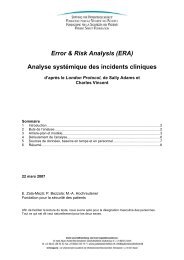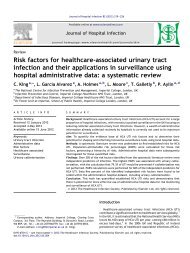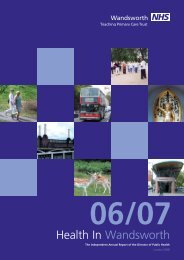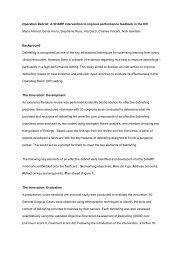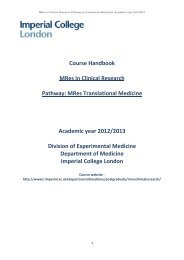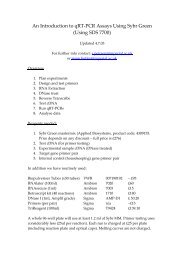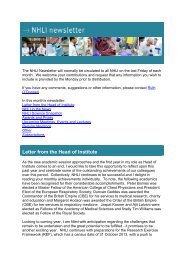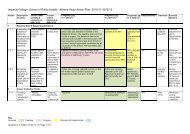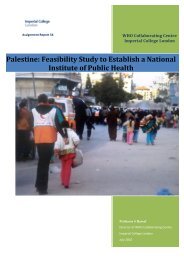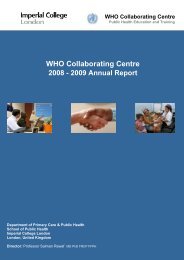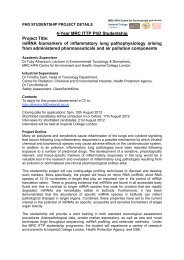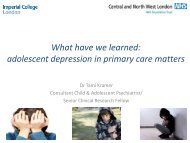QOF Plus Year 1 - Imperial College London
QOF Plus Year 1 - Imperial College London
QOF Plus Year 1 - Imperial College London
You also want an ePaper? Increase the reach of your titles
YUMPU automatically turns print PDFs into web optimized ePapers that Google loves.
which additional priority areas would be included in <strong>QOF</strong>+ through a structured consultation toprioritise areas on the basis of their importance.The consultation method used incorporates aspects of both the Delphi Technique and the RANDAppropriateness Method. These are robust research methodologies with substantial literature tosupport them. The approach involves identifying experts and obtaining their views anonymously.This provides qualitative and quantitative information on expert views.The Delphi technique is a postal method which involves two or more rounds of questionnaires.Researchers clarify a problem, develop questionnaire statements to rate, select panellists to ratethem, conduct anonymous postal questionnaires, and feed back results (statistical, qualitative, orboth) between rounds (Campbell et al., 2003).The RAND appropriateness method requires a systematic literature review for the condition to beassessed, generation of indicators based on this literature review, and the selection of expertpanels. A postal survey then takes place, in which panellists are asked to read the evidence andrate the preliminary indicators, and a face to face panel meeting (not conducted in thedevelopment of the <strong>QOF</strong>+ indicators), in which panellists discuss and re-rate each indicator. Itincorporates a rating of the feasibility of collecting data (Campbell et al., 2003). It has beendescribed as the only systematic method of combining expert opinion and evidence (Naylor,1998).The rating scale used was based on the RAND appropriateness method. Indicators with an overallmedian rating of 7, 8, or 9 without disagreement for each criterion of importance, scientificsoundness, feasibility and clarity were retained; indicators rated with an overall median of 1-3 were removed; indicators rated with an overall median of 4-6 were rated as equivocal, andthese were further discussed by the group and retained if thought to be particularly important toinclude within <strong>QOF</strong>+. Disagreement was defined as 30% or more scores in both the bottom (1-3)and top (6-9) tertile.After obtaining questionnaire responses from the local stakeholder panel in the first round, asecond round of structured consultation was used to achieve consensus among respondents.Respondents were provided with a summary of the panel’s responses from the first round andasked to consider their own responses in light of this, rating each indicator again using the samemethod as in the first round.The results of this consultation showed consensus for the following indicator areas: CVD PrimaryPrevention, Alcohol, Smoking, Smoking in Pregnancy and Breastfeeding. In addition, the areas ofcervical screening and immunisations were rated as equivocal and were retained by the group inview of their local importance. Following further discussion, it was felt that since cervicalscreening indicators were already incorporated into national <strong>QOF</strong>, they could be incentivised in<strong>QOF</strong>+ by raising thresholds instead of developing new indicators. It was decided that the DirectedEnhanced Service (DES) currently in place for Immunisations was comprehensive and that itwould not be developed further through <strong>QOF</strong>+. The remaining potential indicator areas were notdeveloped further at this stage as they did not achieve consensus on ratings of importance.Indicators relating to measurement of patient experience, self management of long-termconditions and new entrant screening for TB were however developed at a later stage by the PCTthrough the methodology for the non-clinical indicators, and included within the “patientexperience”, “patient information” and “new patient screening” domains.133



